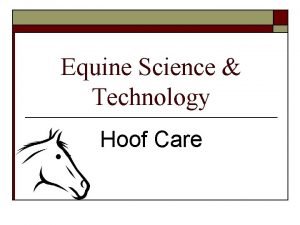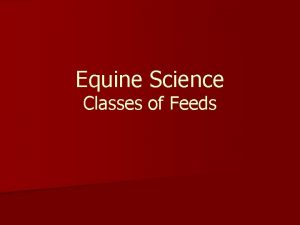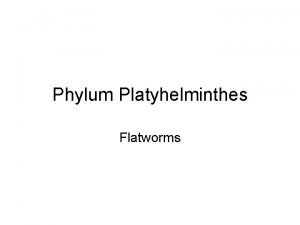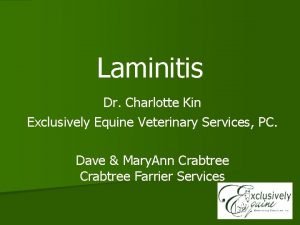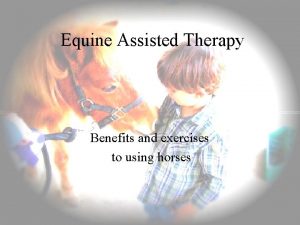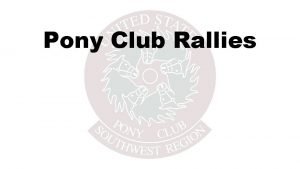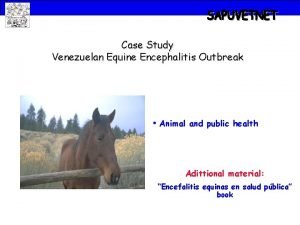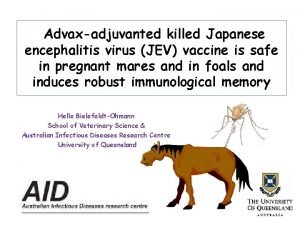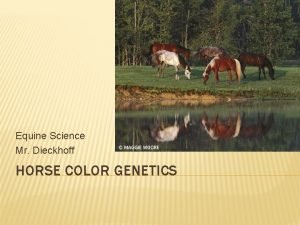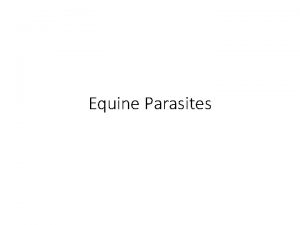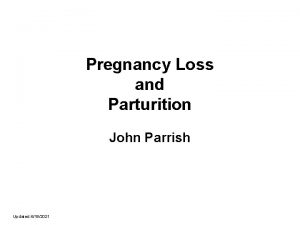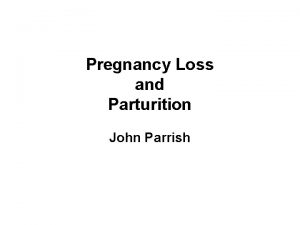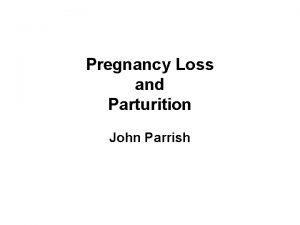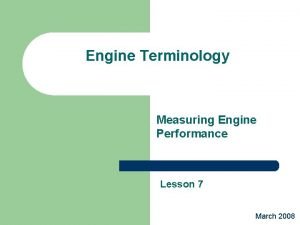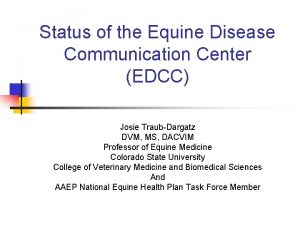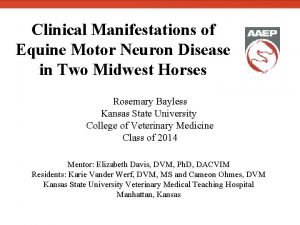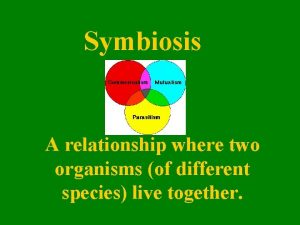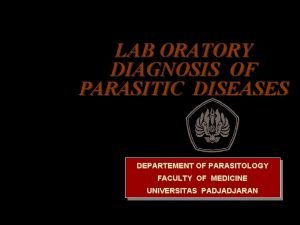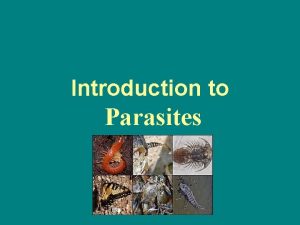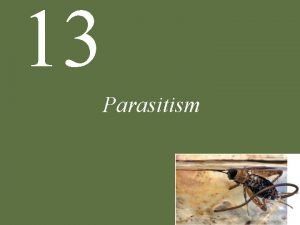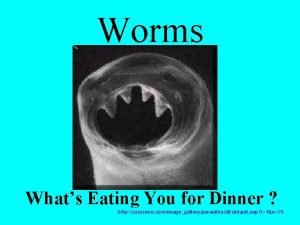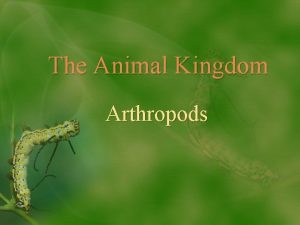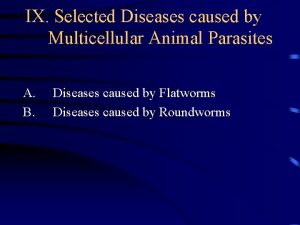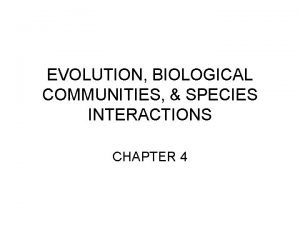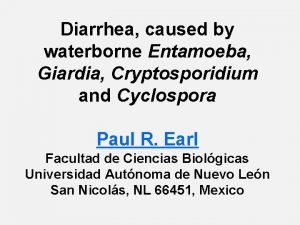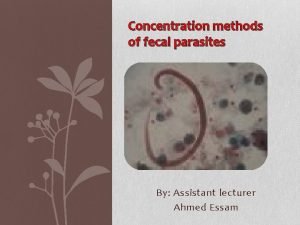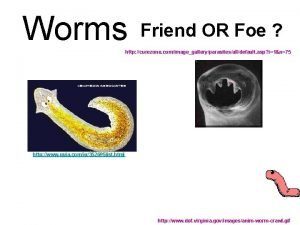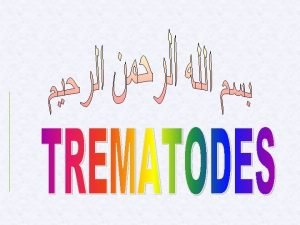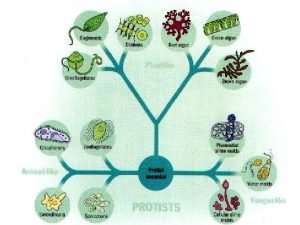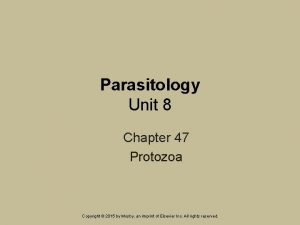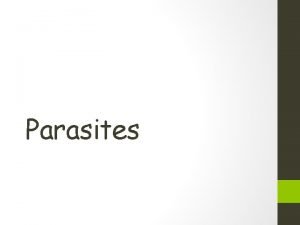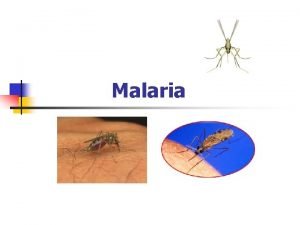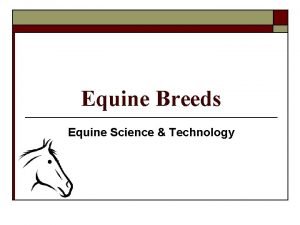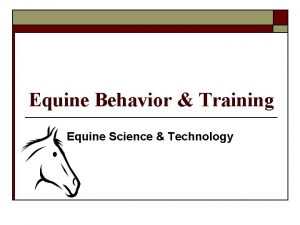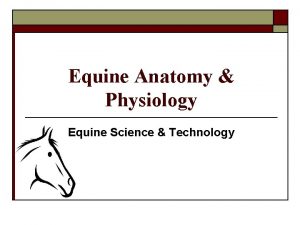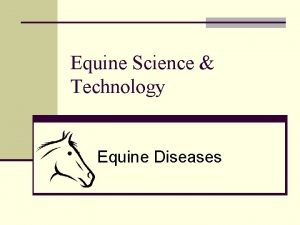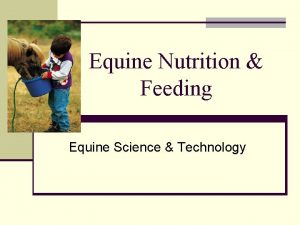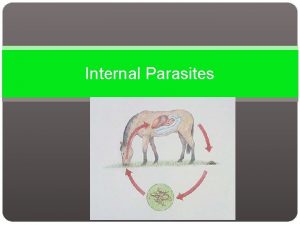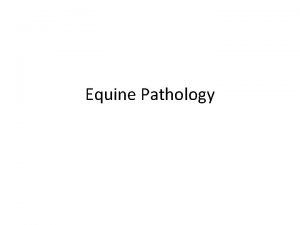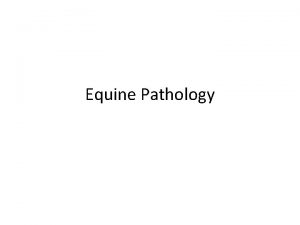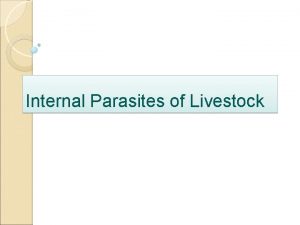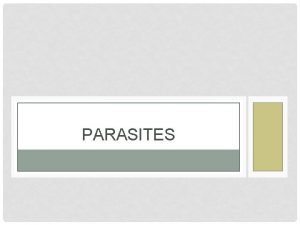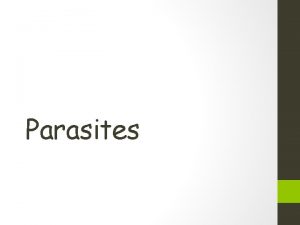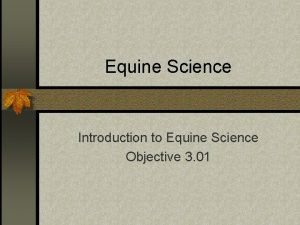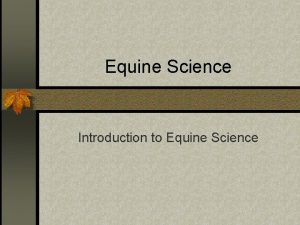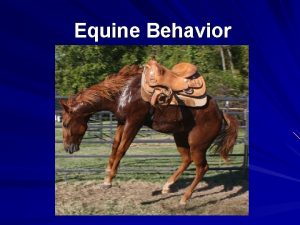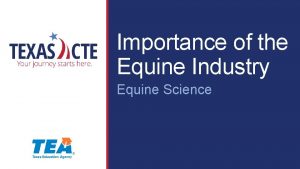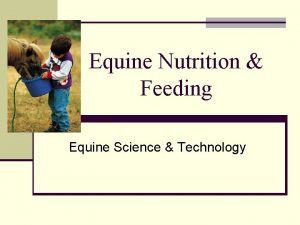Equine Science INTERNAL PARASITES INTERNAL PARASITES Why should












































- Slides: 44

Equine Science INTERNAL PARASITES

INTERNAL PARASITES � Why should we be concerned? � Affects: � Reproduction � Growth � Performance � Overall � How well being many internal parasites are known to affect horses? � >150

INTERNAL PARASITES � What types of internal parasites are we most concerned with? � Ascarids � Strongyles � Pin Worms � Bots � Threadworms � Tapeworms

ASCARIDS (ROUNDWORMS) � Primarily � Foals � Adult � 5 affects? ? and young horses parasite may reach to 22 inches � Immunity develops by exposure during adolescence � Damage begins during migration

ASCARIDS (ROUNDWORMS) � Damage includes: � Physical damage, inflammation, and scaring of liver and lung tissue � May also cause: � Digestive irritations � Decreased feed absorption � Possibly colic

ASCARIDS (ROUNDWORMS) � Transmission? � Swallow � Eggs eggs with feed, pasture, or water hatch and larvae burrow into S. I. � Travel to liver, heart, and lungs � Migrate via blood supply from lung tissue to air spaces � Coughed mature up, re-swallowed, return to S. I. and

ASCARIDS (ROUNDWORMS) � 3 months to complete life cycle � Eggs will start appearing in manure � 10 -13 � Female wks old worm will lay up to � 200, 000 eggs/d � Larva develops in ~2 wks � Eggs are very resilient and may remain infective for years in pastures or stalls

ASCARIDS (ROUNDWORMS) � Typically passed from one foal crop to another � Prevention requires � de-worming at least every two months through the first year of life � Some foals will cough and nasal discharge (no response antibiotics)

ASCARIDS (ROUNDWORMS) � Signs include un-thriftiness, pot belly, rough hair coat, slow growth, and depression


STRONGYLES � Most significant and most common � Occur � All in what ages? ages; except neonatal foal � Sexually mature strongyles are found � Within the L. I. � Commonly � Large divided into two groups and Small

STRONGYLES � Majority of larvae occur on pasture vegetation � Little transmission indoors � Extremely resistant to adverse weather conditions � Survive � Killed � Once freezing winters easily; however by hot, dry summer conditions ingested � Enter the lining of the S. I. , cecum , and L. I.

LARGE STRONGYLES � Three significant species: � Strongylus vulgaris (bloodworms) � Larvae burrow into small arteries in the gut wall and migrate to the anterior mesenteric artery � Main � Migration blood supply to digestive tract causes disruption of blood flow by formation of blood clots in the artery

LARGE STRONGYLES � Larvae remain in anterior mesenteric artery � ~120 � Start days while they grow and develop a return migration � Down � Upon the arteries to the L. I. maturation � Females may lay several thousand eggs/d � Passed into manure � Life � ~6 cycle takes to 7 mo.

LARGE STRONGYLES

SMALL STRONGYLES � Strongylus endentatus � Strongylus equinus � Similar life cycles but not as dangerous � Migrate within the liver, causing damage, and then return to the L. I. � 8 to 11 month life cycle

SMALL STRONGYLES � De-wormers � Reduced have the significance of these parasites � Migrate beyond the lining of the small intestine � Tissue � May damage is somewhat less severe cause diarrhea & increased chances of colic


PINWORMS � Not very harmful � Relatively � Adults found primarily in � Colon � Lay simple life cycle and rectum eggs around anus � Contaminate pastures, water, bedding, etc.

PINWORMS � After ingested � Develop into maturity in the colon and rectum without a migratory state � Damage is minor � Produce severe irritation around the tail � Causes rubbing

STOMACH BOTS � Larvae � Adult of the Bot Fly fly resembles a honey bee � Females lay eggs on the hairs of horses, especially legs � Friction and moisture is necessary for hatching

STOMACH BOTS � Horse licks area where bots are attached � Larvae attach to tongue � Burrow � Those into the tissue of the mouth attached to neck, mane, and face � May migrate to mouth

STOMACH BOTS � After ~ three weeks � Second stage larvae emerges that is swallowed � Attaches to the lining of the stomach � Spend lining � Then ~ 9 months attached to stomach pass out in manure � Pupate into adult flies

STOMACH BOTS � Life cycle depends on � The � Adult larvae over-wintering in the stomach flies are active from � Late spring to the killing frost � Treatment for bots should be scheduled from � Mid to late summer � Again after a killing frost

BOT EGGS

BOT LARVAE

BOT FLY

STRONGYLOIDES (THREADWORMS) � Mainly � Foals infects young foals 4 -47 d old become infected by � Ingesting � Larvae larvae in the dam’s milk migrate through the lungs and S. I. � Causing injury while passing

STRONGYLOIDES (THREADWORMS) � Life �< cycle can be completed in two weeks � Creates potential for severe infections in short time intervals � Foals � by will quickly reject the infection 60 – 90 d of age

STRONGYLOIDES (THREADWORMS) � Main problem is � Diarrhea, which may not respond to treatment � May become extremely dehydrated � May accompany “foal heat” diarrhea

TAPEWORMS � Occurs � An in all ages of horses intermediate host (ingestion of mite) � Once ingested � Takes about two to four months for tapeworm to mature � Mature worms first occur in weanlings and yearlings

TAPEWORMS � Large number can cause ulceration in L. I. cecum, and colon � May also cause intestinal blockage � Pyrantel pamoate is effective in removing by � Doubling � What normal dosage is the most common drug for removal � Praziquantel

PREVENTION AND CONTROL OF INTERNAL PARASITES � No way to eliminate � Factors affecting internal parasite loads include: � Season of year � Humidity � Rainfall � Age of Horse � Concentration of Horses on Land

PREVENTION AND CONTROL OF INTERNAL PARASITES � Key to successful control program is � Interruption of the life cycle � What is primary means through which Parasites spread? � Manure � Feed stalls contaminates and water supply, pastures, paddocks, and

PREVENTION AND CONTROL OF INTERNAL PARASITES � Sanitation � Parasite � Proper � Help plays an important role in reduction manure disposal will prevent contamination � Manure should be � Composted before spreading on pastures currently being grazed

PREVENTION AND CONTROL OF INTERNAL PARASITES � If manure is not composted � Should � Good be spread on un-grazed pasture management can � Dramatically � Should reduce internal parasites prevent overcrowding

PREVENTION AND CONTROL OF INTERNAL PARASITES � Mowing and harrowing helps � Break up manure � Exposes larvae to existing climatic conditions � Should be cautious of mowing and harrowing � On occupied pastures � Grazing cattle after horses may be beneficial

PREVENTION AND CONTROL OF INTERNAL PARASITES � Separate � Class, group and feed by stage of production, and/or age � Yearlings should be managed differently than brood mares. Why? � They are affected by different types of parasites � Should also be on a different Deworming schedule

PREVENTION AND CONTROL OF INTERNAL PARASITES � Try not to feed on the ground � Provide hay mangers and feed bunks � Make sure mangers and bunks are cleaned regularly � Make sure water supply is regularly cleaned and free of fecal material

PREVENTION AND CONTROL OF INTERNAL PARASITES � Many different commercial products are available for parasite control � Differ in their ability to remove internal parasites � Important to be familiar with � Anthelmintics are affected � De-wormers � Be and for which parasites alone will not effective in parasite control if management is poor

PREVENTION AND CONTROL OF INTERNAL PARASITES � What are the most common physical forms of anthelmintics? � Paste � Stomach tube � Continuous Method �Consume small daily doses �Continuous control except for bots

PREVENTION AND CONTROL OF INTERNAL PARASITES � No schedule fits all horses � Basic guidelines: � Most veterinarians feel that horses should be de-wormed at least four times/year � This would include: �Strongyles, �Botacide �Foals Ascarids, and Pinworms in early spring and late fall every 30 to 60 d for first year

PREVENTION AND CONTROL OF INTERNAL PARASITES � Rotation of de-wormers is also important � Parasites may become resistant to particular classes � Parasite control can help reduce colic and increase performance

 Equine science
Equine science Equine science
Equine science Pictures
Pictures Internal and external parasites
Internal and external parasites Exclusively equine vet
Exclusively equine vet Lingfield equine vets
Lingfield equine vets Equine definition
Equine definition Us pony club stall card
Us pony club stall card Equine encephalitis
Equine encephalitis Equine encephalitis
Equine encephalitis Pasture pals equine rescue
Pasture pals equine rescue Rhinopneumonitis definition
Rhinopneumonitis definition Color calculator horse
Color calculator horse Equine
Equine Parturition
Parturition Equine
Equine Equine
Equine Electrical formula
Electrical formula Equine disease communication center
Equine disease communication center Equine injury database
Equine injury database Equine motor neuron disease
Equine motor neuron disease Economics … my favorite subject at school
Economics … my favorite subject at school Rule of 70 population growth
Rule of 70 population growth Dont ask why why why
Dont ask why why why What is symbiotic relationship
What is symbiotic relationship Kato katz technique
Kato katz technique Parasite introduction
Parasite introduction Parasite
Parasite Bacteria virus fungi and parasites
Bacteria virus fungi and parasites Hookworm vs threadworm
Hookworm vs threadworm Embryo development
Embryo development Parasites alimentaires
Parasites alimentaires Multicellular animal parasites
Multicellular animal parasites Parasites of medical importance
Parasites of medical importance What do parasites eat
What do parasites eat Parasite consumer
Parasite consumer Parasites
Parasites Ova cysts and parasites
Ova cysts and parasites Curezone parasites
Curezone parasites Autoinfection parasites examples
Autoinfection parasites examples Polyphyletic group
Polyphyletic group Sarcomastigophora are unicellular immotile parasites
Sarcomastigophora are unicellular immotile parasites Parasites of livestock vocabulary
Parasites of livestock vocabulary Bilateral symmetry worm
Bilateral symmetry worm Mp under microscope
Mp under microscope
